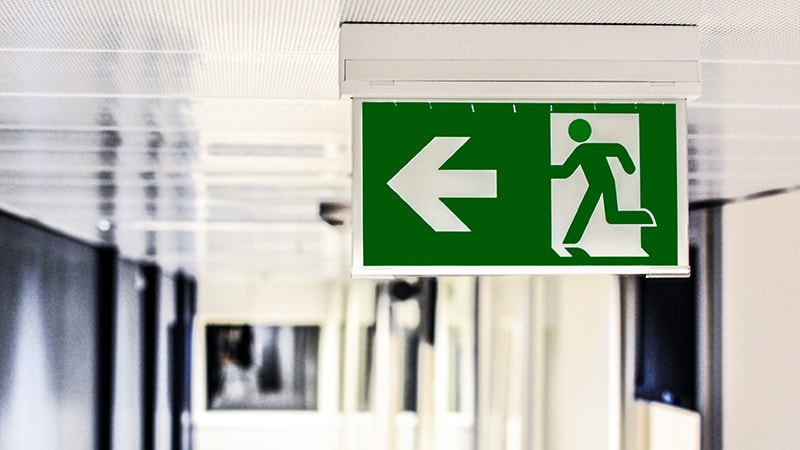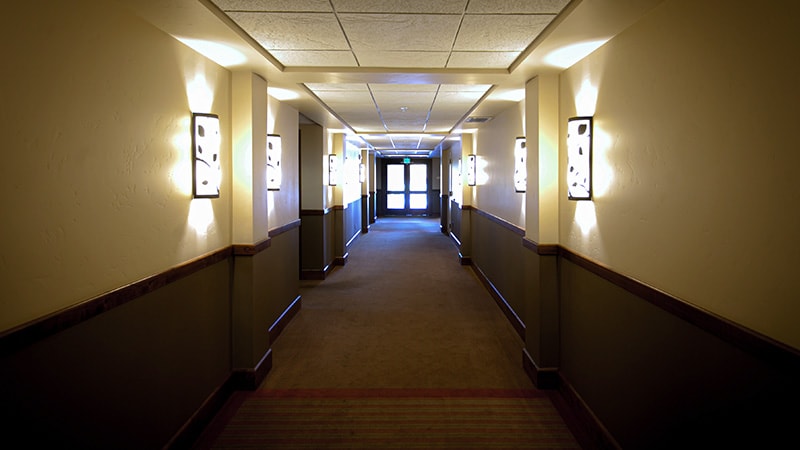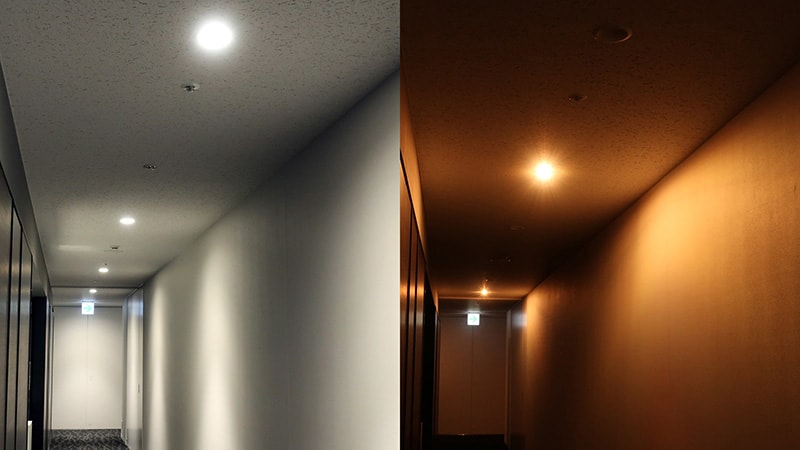
In the hospitality industry, ensuring the safety and comfort of guests is paramount. The immediate panic after an unexpected power outage is one of the biggest threats to guest safety. Luckily, modern emergency lighting solutions have removed the threat of darkness. However, navigating the various safety codes, regulations, and hotel requirements is challenging.
This article delves into emergency lighting regulations, unraveling its mysteries, highlighting legal compliances, and summarizing requirements for your hotel.
What is Hotel Emergency Lighting?
Emergency lighting is a collection of light fixtures and illuminated exit signs in hotels that automatically turn on in case of an unexpected power outage or compromised electricity supply caused by natural disasters.
In the case of a power outage, the hospitality industry has to prioritize guest safety first, navigating emergency second, and hotel reopening last. Emergency lighting provides clear visibility and enhances guest confidence in the hotel.
Emergency lighting systems have two core elements.
- Backup Lighting that focuses on general visibility and illumination in the hotel after a power outage.
- Emergency Escape Lighting focuses on illuminating escape routes and exit signs.
In the United States, backup lighting regulations are relaxed and less prioritized from a safety perspective. Contrarily, exit sign requirements (location, brightness, and maintenance) are heavily emphasized.
The rationale behind this approach is simple. In an emergency, such as a fire (which is more common in some states), guests should be able to evacuate the premises quickly. Since guests are not expected to stay in the hotel during an emergency, backup lighting isn’t as important.
Understanding Emergency Lighting Regulations

Implementing emergency lighting in hotels is easy. However, accomplishing this task while meeting legal compliances and regulations is quite difficult.
First – Navigating emergency lighting regulations is challenging because they are designed as general building codes for hospitals, warehouses, factories, restaurants, and hotels.
Second – Several different regulating bodies provide emergency lighting regulations. Understanding which regulations apply to your hotel requires thoroughly reviewing state laws.
Here are the five major emergency lighting regulations that apply to hotels.
1. National Fire Protection Association (NFPA) Guidelines
NFPA is a US-based non-profit advocating for increased fire protection safety. They develop safety codes and regulations for building safety, industrial practices, and emergency response. The NFPA 101, National Fire Protection Life Safety Code, outlines strategies for increasing residence protection based on building construction techniques, building occupancy, and fire hazard management.
It has a section dedicated to emergency lighting practices, such as design, operation, and maintenance requirements. Although hotel owners are not legally obligated to comply with NFPA standards, compliance helps businesses take a more proactive approach to safety.
OSHA also recognizes compliance with NFPA standards as a valid approach to worker safety.
2. Occupational Safety and Health Administration (OSHA) Guidelines
OSHA is a regulatory body of the United States Department of Labor. It provides worker safety guidelines for businesses and holds them accountable for safety violations. OSHA views emergency lighting as a way to ensure employee workplace safety, but the rules also ensure guest safety.
A key aspect of US safety regulations is emphasizing exit signs and routes. OSHA Regulations 1910 outlines operational and maintenance requirements for the placement and illumination of exit signs.
Failure to meet OSHA regulations can result in fines or legal action by the US Department of Labor.
3. European Standards
Moving on, our European Union (EU) friends have more detailed hotel emergency lighting regulations. The EU is comprised of 27 countries, and its regulations are designed to a higher standard so that all of its member nations are satisfied with the results.
The BS EN 1838 standard is widely seen as the definitive EU emergency lighting guideline for hotels. Alternatively, businesses in the UK can look at the BS EN 5266-1, which highlights UK-specific rules and regulations against emergency lighting and exit signs.
4. International Electrotechnical Commission (IEC) Standards
Unlike the NFPA, the IEC is an electronics and electrical standards organization that looks at all safety, efficiency, and consumer protection-related practices. Compliance with IEC standards is a good way for international hotel chain owners to ensure that all buildings follow consistent rules and regulations.
IEC 60598 outlines luminaire (light fixture) requirements for emergency lighting and provides in-depth information on the best practices for installing and maintaining commercial lighting.
5. State Level Building Safety Codes
While general guidelines for emergency lighting systems remain the same across states, you should always review your state’s building codes. Local, state-level life safety codes provide comprehensive guidelines for emergency lighting installation in new hotels and retrofitting old ones.
State building codes cover emergency lighting rules and regulations. The 2019 California Building Code defines lighting requirements for all business owners in the state.
Comparing General Emergency Lighting Regulations
| Regulations | Scope | Applications |
|---|---|---|
| NFPA 101 | International | Hotel Illumination Requirements & Exit |
| OSHA 1910 | United States | Worker Safety & Exit Signs |
| BS EN 1838/5266-1 | European | Hotel Illumination & Requirements |
| IEC 60598 | International | Hotel Illumination Requirements |
| State Building Codes | US State Laws | Building Safety & Exit Signs |
Emergency Lighting Regulations for Hotels: Key Requirements

Now we know about the various regulating authorities in the hotel lighting industry. Let’s discuss the hard numbers they have set for hotel emergency lighting.
Although the exact requirements will differ from hotel to hotel based on building size, amenities offered, and location, these cover all the important aspects of emergency lighting regulations.
Installation Locations
A hotel building has several critical points that can be hazardous in case of a complete blackout. Due to a lack of visibility, panic can quickly set in, and guests can get seriously injured. Thus, emergency lighting is essential in helping everyone calm down and ensuring safe guest evacuation.
Here are the key choke points in a hotel building that must have reliable safety lighting.
- Open Areas
Open areas refer to any hotel space with a 60 sq. meters or more floor area. As guests will likely congregate in large open spaces, emergency lights act as anti-panic elements and help guide them to escape routes.
- Emergency Exits & Escape Routes
Every door, hallway, or staircase that leads to the outside of the building must have a light-up exit sign. Whether it’s a fire, an earthquake, or a flood, the priority is always to help guests’ safety and ensure everyone can easily find their way to an escape route.
- Outdoor Areas Close to Exits
After guests leave the hotel building and head to the parking area or main street, adequate outdoor lighting (1 lux) should be provided for safe navigation. Outdoor emergency lighting is especially necessary for hotels with steep entrance steps.
- Elevator Cabins
No one wants to be trapped in a small, confined space in pitch-black darkness, so emergency lights in elevators are a necessary anti-panic measure.
- Stairs, Escalators, and Walkways
Most escape routes will lead guests through some stairways. Small missteps on the stairs can cause bodily harm to an individual and block the path for others.
- Bathrooms
Emergency lighting must be installed in bathrooms with at least eight square meters of floor space. Disabled toilets must also have a dedicated emergency light to assist the physically impaired.
There are no strict emergency lighting regulations for bathrooms that are part of a larger hotel room. Oddly enough, emergency lighting regulations don’t require hotels to have backup lights in bedrooms.
- Electrical Distribution Rooms
Emergency lighting must illuminate all electricity generators, control, and power distribution rooms so hotel staff can monitor and maintain emergency lighting systems.
- Indoor Car Parks
Guests walking to their cars in the dark while others are driving out of the car park is a recipe for disaster. Proper illumination must ensure guests are not blindsided by a moving car.
Duration Requirements
Entertainment venues (cinemas, theaters, etc.) and buildings with a sleeping risk (hotels, apartments, etc.) must have a minimum emergency lighting duration of 3 hours to ensure all guests have enough time to evacuate. Factories, schools, offices, and workshops require less time for evacuation, and this 1 hour of power on time is sufficient.
- EU standards require a flat 3 hours of emergency lighting operation.
- NFPA 101 states that 1.5 hours of operation at a minimum of 0.1 fc (1 lux) is adequate. After 1.5 hours, the emergency lights may lose up to 1/40 of their illumination (minimum 0.06 fc) but remain operational as long as backup power is available.
Brightness Requirements
Brightness requirements vary by location and application. As discussed previously, most open areas are expected to have a minimum illumination of 0.1 fc or 1 lux. However, the illumination requirements for task lighting and exit signage are higher.
- Exit signs must have a surface illumination value of 5 fc (54 lux). To ensure guests can see the signage from a fair distance away.
- Task areas like kitchens, first-aid rooms, and other hotel spaces and escape routes must have emergency lighting at 0.5 fc (5 lux).
Power and Battery Requirements
The backup power supply should be capable of running all emergency lights and exit signs at their minimum required brightness for over 3 hours. Electrical contractors and on-site engineers can help you calculate the minimum power requirements based on the number of fixtures in the building.
All exit signs must have an independent power supply with a test button on the side. Pressing the test button disables the main AC power, and if the exit signs turn off, the internal battery is compromised.
Solar-powered emergency lights are one of the latest innovations in hotel lighting. They can help hotels reduce their electricity costs and increase lighting power during the day. Again, it should be noted that solar batteries must have enough capacity to maintain emergency lighting for three hours.
Maintenance Requirements
Regular testing and maintenance are important parts of an effecting emergency lighting design. Hotels must ensure that their emergency lighting system will not fail when needed.
- Once a month, a brief test (1 minute) must be conducted to simulate a power outage and determine whether all emergency LED lighting in hotel rooms is operational.
- Internal batteries for exit signs must be tested each month and replaced after significant degradation.
- Older exit signs with non-replaceable batteries or no longer commercially available (outdated) must be replaced.
Periodic testing and maintenance of internal exit sign batteries are often more important than general emergency illumination.
Emergency Lighting Requirements for Hotels
| Regulation Attribute | Requirements |
|---|---|
| Install Locations |
|
| Duration |
|
| Brightness |
|
| Power & Battery |
|
| Maintenance |
|
Backup Power Options for Emergency Lighting Systems

The entire purpose of emergency lights is to stay on even during power outages or emergencies. So, it is only natural that manufacturers focus heavily on the power supply options for emergency light fixtures.
National Fire Protection Association standards state that all emergency lights must have a backup power source. It could be a built-in battery or an external UPS (Uninterruptible Power Supply) system.
Here are five backup power options for your emergency lighting fixtures.
1. Central Powered Emergency Lights
Central power refers to a single backup generator or battery pack that delivers electricity to the emergency lights and exit signs. The hotel’s light fixtures are wired together and terminated to a backup power supply. Thus, in the case of a power outage, hotel staff can switch to the backup supply, which will immediately turn on every emergency light and exit sign.
The convenience of a single-point power backup is also its biggest drawback. If that one backup battery or generator fails, then the entire building will be plunged into darkness.
Hence, all local and international emergency lighting codes require exit signs to have independent power sources. If the central backup battery fails, the exit signs will continue to operate independently.
2. Self-Contained Emergency Lights
Self-contained emergency lights have a small internal battery that provides a few hours of runtime during a power outage. These independent battery-powered fixtures receive power from the main AC line and charge the batteries.
Hotels have two options for emergency lighting installation.
- Non-Maintained Lights – Clear fixtures that only turn on during a power outage.
- Maintained Lights – Regular ceiling and wall-mounted lights with a backup power source.
Self-contained battery-powered lights generally come in big, bulky units that often clash with your hotel’s visual design and aesthetics. They offer reliability and convenience at the cost of presentation.
It should be noted that batteries degrade over time, and monthly maintenance checks are necessary for emergency lighting.
3. Maintained Emergency Lights
Maintained emergency light fixtures run on main AC power from the socket and switch to a backup supply. These lights combine regular hotel ambient and emergency lighting into a single design that serves both purposes.
Not every light in your hotel needs to have an internal battery pack. Generally, one out of every five fixtures in hotels and restaurants should be maintained.
4. Non-Maintained Emergency Lights
Non-maintained lights remain dormant throughout their lifespan and only turn on during emergencies, natural disasters, and power outages. These units provide versatility to your emergency lighting designs.
Unlike maintained units, which typically run at higher wattages, non-maintained units can have low-wattage LED bulbs that run longer. Energy-efficient backup power solutions are only effective if light fixtures’ power consumption is reasonable.
5. Smart Emergency Lighting Systems
Innovations in hotel emergency lighting are rare, and most new features are focused on battery and LED technology. However, the recent rise in smart home technology has brought a new option for emergency lighting systems: Smart Lighting Controls.
Hotel owners can now monitor the status and battery health of each light fixture installed in the building. Remote monitoring also reduced the time and effort required for monthly maintenance checks.
Conclusion
Emergency lighting in hotels is an incredible achievement for our modern society. As it is key to guest safety, hotel owners have a legal and moral obligation to provide high-quality backup lighting to guests. Most regulations emphasize the need for clear and easily visible exit signs throughout the hotel building to ensure quick and safe evacuation. New building owners should always hire an experienced electrical contractor to help them comply with national and state safety codes and regulations.
Prioritize Guest Safety with RC Lighting!
RC Lighting is a titan of the architectural lighting landscape, with over a decade of manufacturing experience. Our energy-efficient Indoor LED Lighting solutions ensure guest safety without disrupting your hotel’s aesthetics.
We take pride in the quality of our products, which are CE, RoHS, UL/ETL, and ISO 9001 Certified. RC Lighting also offers value-added services such as OEM solutions and low MOQs.
Keep your guests safe and your hotels prosperous. Contact us Now!



